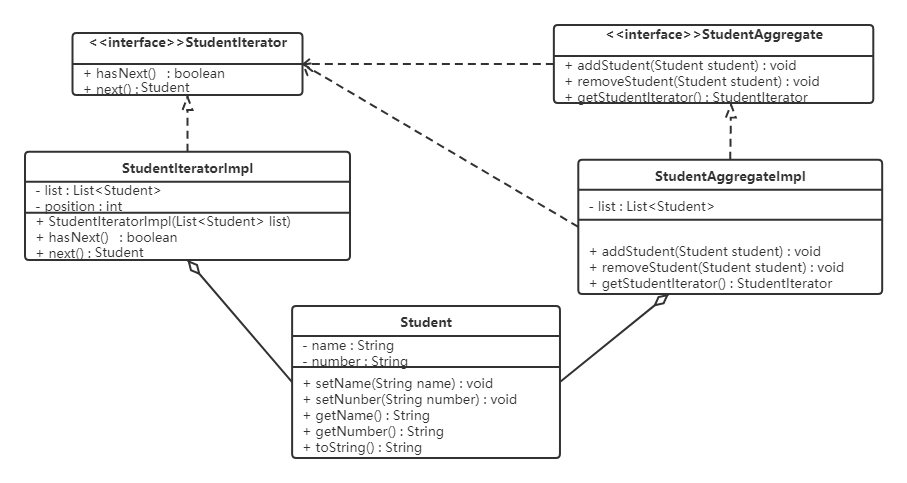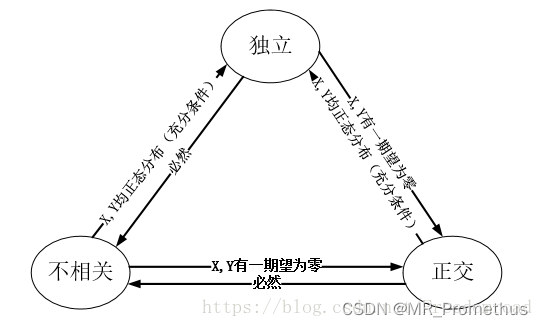文章目录
- 迭代器模式
- 解决的问题
- 结构
- 实例
- 存在的问题
- 适用场景
- JDK 源码 - Iterator
行为型模式用于描述程序在运行时复杂的流程控制,即描述多个类或对象之间怎样相互协作共同完成单个对象无法单独完成的任务,它涉及算法与对象间职责的分配。行为型模式分为类行为模式和对象行为模式:
-
类行为模式:采用继承机制来在类间分派行为
-
对象行为模式:采用组合或聚合在对象间分配行为
由于组合关系或聚合关系比继承关系耦合度低,满足“合成复用原则”,所以对象行为模式比类行为模式具有更大的灵活性。
行为型模式分为:
- 模板方法模式
- 策略模式
- 命令模式
- 职责链模式
- 状态模式
- 观察者模式
- 中介者模式
- 迭代器模式
- 访问者模式
- 备忘录模式
- 解释器模式
以上 11 种行为型模式,除了模板方法模式和解释器模式是类行为型模式,其他的全部属于对象行为型模式。
迭代器模式
迭代器模式:提供一个对象来顺序访问聚合对象中的一系列数据,而不暴露聚合对象底层的表现形式(列表,栈,树)。
解决的问题
聚合对象就是一个容器,容器肯定能够遍历元素,容器的主要职责是高效存储元素,对于复杂的结构存在多种遍历的方法(比如树),如果将遍历的方法写入容器中,就模糊了容器的主要功能是高效存储元素,迭代器就是将遍历发方法从容器抽离出来,这样我们遍历容器时,就去与迭代器接口去交互,而不需要与容器交互,符合依赖倒转原则
结构
- Aggregate,抽象聚合角色:定义存储、添加、删除聚合元素以及创建迭代器对象的接口。
- ConcreteAggregate,具体聚合角色:实现抽象聚合类,返回一个具体迭代器的实例。
- Iterator,抽象迭代器角色:定义访问和遍历聚合元素的接口,通常包含 hasNext()、next() 等方法。
- Concretelterator,具体迭代器角色:实现抽象迭代器接口中所定义的方法,完成对聚合对象的遍历,记录遍历的当前位置。
实例
 )
)
实体类
@Data
@ToString
@AllArgsConstructor
@NoArgsConstructor
public class Student {private String name;private String number;
}
抽象迭代器元素
public interface StudentIterator {//判断是否还有元素boolean hasNext();//获取下一个元素Student next();
}
具体迭代器
public class StudentIteratorImpl implements StudentIterator{private final List<Student> list;private int position=0;// 记录遍历时的位置public StudentIteratorImpl(List<Student> list) {this.list = list;}@Overridepublic boolean hasNext() {return position<list.size();}@Overridepublic Student next() {//从集合获取指定位置的元素return list.get(position++);}
}
抽象聚合角色
public interface StudentAggregate {//添加学生功能void addStudent(Student student);// 删除学生功能void removeStudent(Student stu);// 获取迭代器对象功能StudentIterator getStudentIterator();
}具体聚合角色
public class StudentAggregateImpl implements StudentAggregate{private List<Student> list = new ArrayList<>();@Overridepublic void addStudent(Student student) {list.add(student);}@Overridepublic void removeStudent(Student student) {list.remove(student);}@Override//获取迭代器对象public StudentIterator getStudentIterator() {return new StudentIteratorImpl(list);}
}测试
public class Client {public static void main(String[] args) {//创建聚合对象StudentAggregateImpl aggregate = new StudentAggregateImpl();//添加元素aggregate.addStudent(new Student("张三", "001"));aggregate.addStudent(new Student("李四", "002"));aggregate.addStudent(new Student("王五", "003"));aggregate.addStudent(new Student("赵六", "004"));//遍历聚合对象//1获取迭代器对象StudentIterator iterator = aggregate.getStudentIterator();//2遍历while (iterator.hasNext()){//3获取元素Student student = iterator.next();System.out.println(student);}}
Student(name=张三, number=001)
Student(name=李四, number=002)
Student(name=王五, number=003)
Student(name=赵六, number=004)
存在的问题
优点:
-
支持以不同的方式遍历一个聚合对象,在同一个聚合对象上可以定义多种遍历方式。在迭代器模式中只需要用一个不同的迭代器来替换原有迭代器即可改变遍历算法,我们也可以自己定义迭代器的子类以支持新的遍历方式。
-
迭代器简化了聚合类。由于引入了迭代器,在原有的聚合对象中不需要再自行提供数据遍历等方法,这样可以简化聚合类的设计。
-
在迭代器模式中,由于引入了抽象层,增加新的聚合类和迭代器类都很方便,无须修改原有代码,满足 “开闭原则” 的要求。
缺点:
- 增加了类的个数,这在一定程度上增加了系统的复杂性
适用场景
- 当需要为聚合对象提供多种遍历方式时。
- 当需要为遍历不同的聚合结构提供一个统一的接口时。
- 当访问一个聚合对象的内容而无须暴露其内部细节的表示时。
JDK 源码 - Iterator
迭代器模式在 Java 的很多集合类中被广泛应用,接下来看看 Java 源码中是如何使用迭代器模式的。
List<String> list = new ArrayList<>();
Iterator<String> iterator = list.iterator(); // list.iterator()方法返回的肯定是Iterator接口的子实现类对象
while (iterator.hasNext()) {System.out.println(iterator.next());
}
Java 中的单列集合都使用到了迭代器,以 ArrayList 举例说明:
- List:抽象聚合类
- ArrayList:具体的聚合类
- Iterator:抽象迭代器
- list.iterator():返回的是实现了
Iterator接口的具体迭代器对象
public class ArrayList<E> extends AbstractList<E>implements List<E>, RandomAccess, Cloneable, java.io.Serializable {public Iterator<E> iterator() {return new Itr();}private class Itr implements Iterator<E> {int cursor; // 下一个要返回元素的索引int lastRet = -1; // 上一个返回元素的索引int expectedModCount = modCount;Itr() {}//判断是否还有元素public boolean hasNext() {return cursor != size;}//获取下一个元素public E next() {checkForComodification();int i = cursor;if (i >= size)throw new NoSuchElementException();Object[] elementData = ArrayList.this.elementData;if (i >= elementData.length)throw new ConcurrentModificationException();cursor = i + 1;return (E) elementData[lastRet = i];}...
}这部分代码还是比较简单,大致就是在 iterator 方法中返回了一个实例化的 Iterator 对象。Itr 是一个内部类,它实现了 Iterator 接口并重写了其中的抽象方法。
当我们在使用 Java 开发的时候,想使用迭代器模式的话,只要让我们自己定义的容器类实现java.util.Iterable并实现其中的 iterator() 方法使其返回一个 java.util.Iterator 的实现类就可以了。






